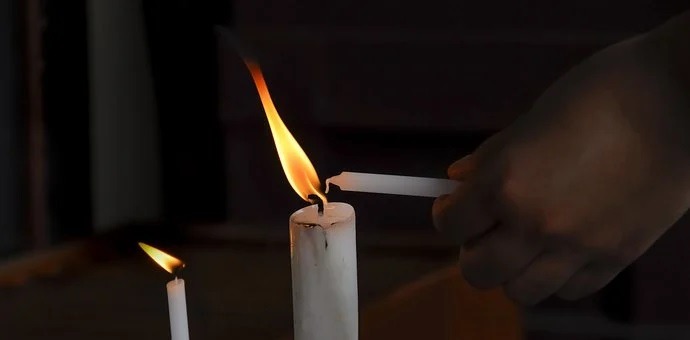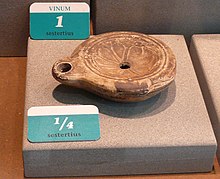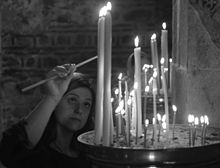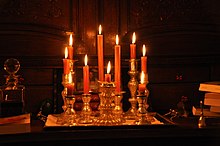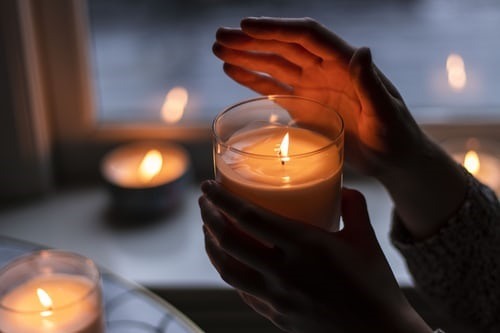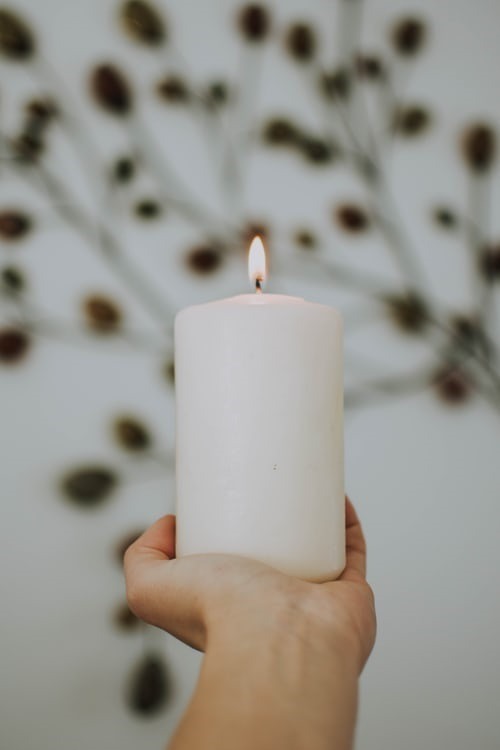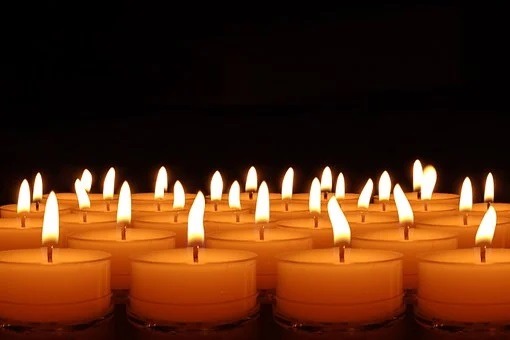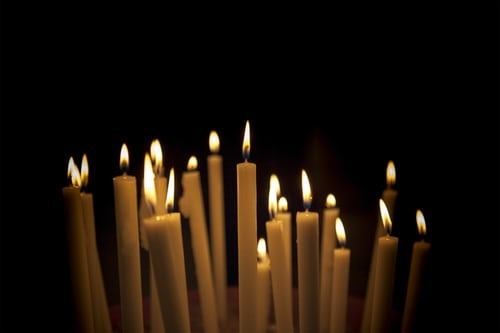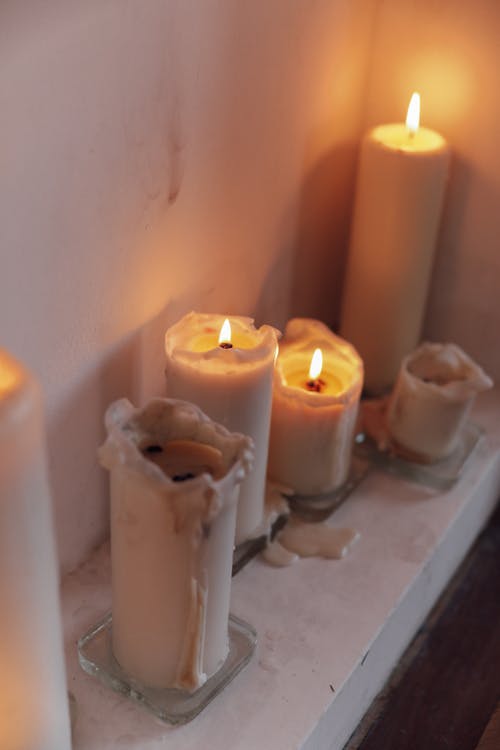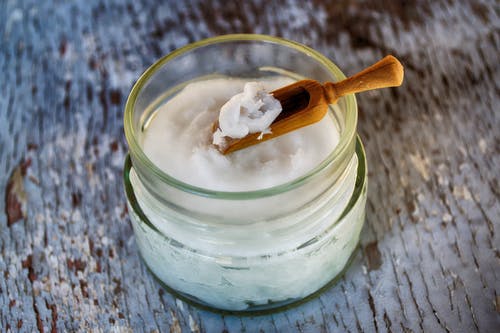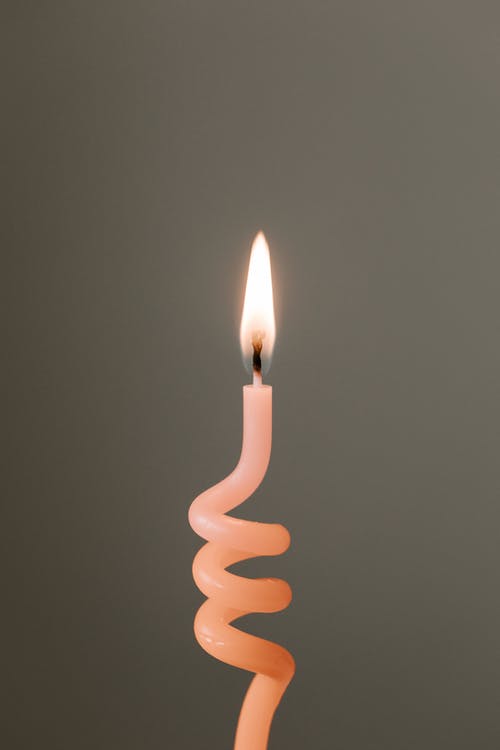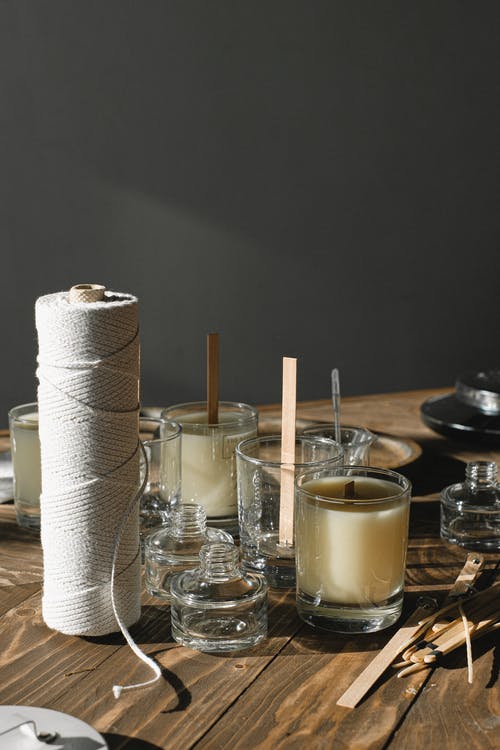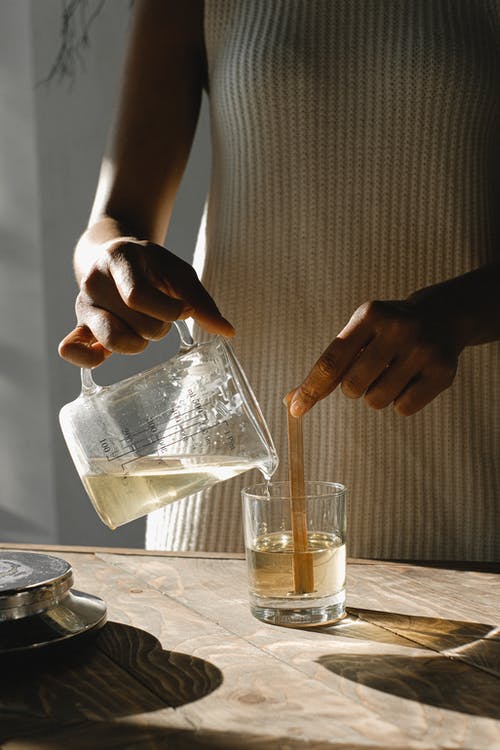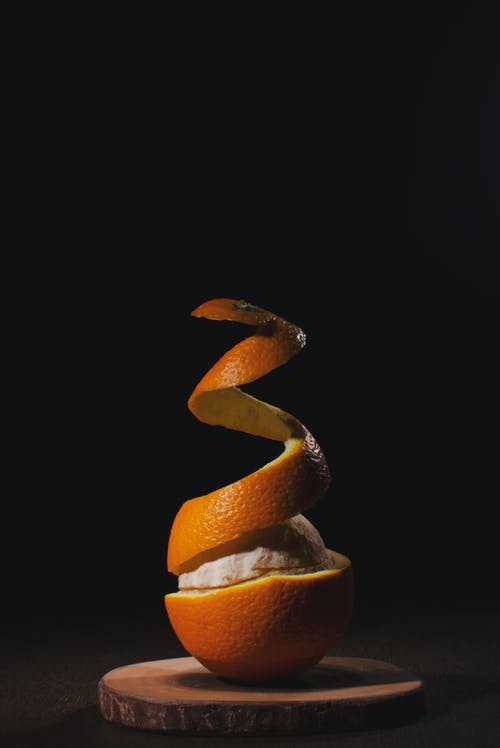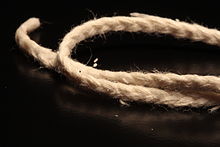A candle is a flammable wick embedded in wax or other flammable solid substance like a tallow. It provides light and scent in some cases. A candle can also be used as a method of keeping time and providing heat. A person who makes candles is known as a chandler. Since then, various candle holder devices have been invented. These can be from a simple table candlestick, also known as candlesticks, or others are known as chandeliers or candelabra.
To burn a candle, a heat source from a lighter or match is used to light the wick of the candle. It melts and vaporizes a small amount of fuel such as wax. A constant flame of a candle comes from the vaporization and the fuel combines with the oxygen in the atmosphere to ignite. If there is a power outage, candles can be used to light up your house or room.
Ultimate Guide to Using Candles for Survival
The flame of the candle is having enough heat to keep the candle burning through a self-sustaining chain of events. The heat of the candle flame melts the top of the solid fuel mass. The liquefied fuel rises through the wick by capillary action and eventually vaporizes to burn in the candle flame.
History of Candle
The word candle comes from the Middle English candel, an Old English and Anglo-Norman candele. Before the candle, people used oil lamps in which a lit wick rested in a container of liquid oil. The Romans began to make real submerged tallow candles from the year 500 BC. Ancient European candles were made from various forms of fats such as tallow, natural fat, wax, etc.
In ancient Rome, candles were made from tallow because of the prohibitive cost of beeswax. They existed in ancient Greece as well but the terminology used makes it difficult to determine. The first survival candles originated around 200 BC in Han China. To your surprise, these survival candles were made from the fat of whales.
In the Middle Ages, candles made from tallow were the most used candles. By the 13th century, candle-making became a guild profession in France and England. The chandlers went from house to house to make candles from the stored cooking fat, or they made and sold their candles in small stores. Beeswax as compared to the tallow of animals burned cleanly. It means it did not have a smoldering flame.
The Beeswax candles were expensive and not affordable by few people to burn them at their homes in medieval Europe. On the other hand, these were widely used for religious ceremonies in church. In the 18th and 19th centuries, spermaceti, a waxy substance that was produced by the sperm whale was used for making superior candles. These candles burned brighter and for a longer period. Also, they were odorless.
Modern Era Of Candles
In the 18th century, rapeseed oil and colza oil were used for cheap candles. In the mid-19th century, candle-making became an industrialized mass market. In 1834 Joseph Morgan, a pewterer from Manchester, England, revolutionized candle making. He patented a machine to make candles making an industrialized mass market. It enabled a continued production of molded candles using a cylinder with a moveable piston that ejects the candles as they solidified.
Later on, the more efficient machine was able to produce 1,500 candles per hour. It enabled the candles to be an affordable product for the masses. The wicks were then made from heavily braided cotton threads. This technique caused the wicks to curl during the combustion and maintain the height of the wick. Also, the height of the flame was maintained using the cotton wicks. Because of much excess but is incinerated, these were known as self-consumable or self-cutting wicks.
In the mid-1850s, James Young succeeded in distilling the paraffin wax from oil, coal, and shales at Bathgate in West Lothian. He developed a commercially and viable method of production of candles. Paraffin was used to make high-quality and inexpensive candles. It was a bluish-white wax that burned with no unpleasant odor and mess, unlike tallow candles. By the end of the 19th century, candles were made from stearic acid and paraffin wax.
Price’s Candles by the late 19th century was the largest candle maker in the world. It was founded by William Wilson in 1830. This candle-making company was the first one to implement the steam distillation technique. Therefore, they were able to manufacture candles from a wide range of raw materials. These raw materials were industrial oil or fats, fish oil, bone fat, skin oil, etc.
Despite the advances in candle making, the candle industry quickly declined the introduction of superior lighting methods such as lamps and kerosene. Also, the invention of the incandescent bulb was in 1879. At this time, candles were now used as more of a decorative item.
Uses Of Candles
Before electric lighting was invented, candles and oil lamps were used for illumination. They were mostly used in areas where there was no electricity. In the current date, candles and oil lamps are still being used in the areas where there is a power outage for a longer period. Until the 20th century, candles were common in Northern Europe.
In today’s developed world, candles are mainly used for aesthetic and olfactory value. They are used to create a warm, soft, and romantic atmosphere. Also, they are used for emergency purposes when there is a power outage for a longer period. In recent years, there has been a huge increase in the use of scented candles.
Emergency Candles
You can stock your home with emergence candles to prepare for disasters and prolonged power outages. An emergency candle provides heat and light during a disaster or power outage. These emergency candles are having unique and great qualities that other candles don’t have.
- They are made of high-quality wax and wick to prevent sparkle.
- They are dripless. It means no wax or mess
- They burn without smoke. So, they don’t make you uncomfortable while using them at home.
- The reusable feature can keep the supplies.
- They burn slowly with reliable light.
- They are fragrance-free. So, when they burn, they don’t pollute the air quality.
The emergency candles are a great addition to any disaster preparedness kit. they made to help in stressful situations. On the other hand, flashlights or lanterns can also work for the longest time but you have to replace batteries or bulbs. The candles or emergency candles don’t need any kind of maintenance and they have no shelf life.
How Long Does An Emergency Candle Last?
You can group emergency candles for more lighting and longer burn time. The emergency candles are expected to last between 7 and 12 hours. You should keep in mind that each brand of an emergency candle is unique in various ways. The size, wax, and wick of the candle determine the lifespan of the candle. When you purchase the candles, time or lifespan is one of the considerations.
If the power outage is for a shorter period, then you can put the candle back in supplies. On the other hand, the glow sticks will not light up your home or room for a longer time as compared to the candles. In survival situations, longer time lighting is an important factor and emergency candles do it at their best.
How Many Emergency Candles Should You Buy?
In survival situations, you don’t have to fill all your free space with emergency candles. You need other supplies too in such situations. Depending on the size of your home, you don’t want to stock up hundreds of emergency candles. Also, you don’t know if dozens of candles will be enough for lighting your home.
When you know the burn time of the emergency candles, you can have a rough estimate that how many candles you should be having in supplies. When the power out in different seasons is approximately for 10 to 12 hours, then you can have dozens of candles. In the period of darkness, you will be asleep for most of the hours.
In reality, you only need four to five hours of emergency lighting per day. These are one of the situations where the power outage is longer than the average eight hours. The place where you live, having extreme weather conditions can determine the blackout period. If natural disasters are more common in your place, then the blackout might be for days or even weeks. Natural disasters such as wildfire, tornados, hurricanes, etc. can cause blackouts for prolonged periods.
It is recommended to have emergency supplies for three days without power. In power outage situations, you should be having supplies of water and food for an emergency. If you are having enough space in your home, you can buy several boxes of emergency candles but not all of them will be used during the blackout. Also, make sure you have an emergency flashlight along with candles.
Are Emergency Candles Best For Blackout?
All the emergency equipment is not best for all situations. Flashlights, stick lights, lanterns, or candles are not the best fit for every situation. But candles have many benefits over other lighting equipment that deserve a place in a first aid kit.
- Candles are not expensive to buy.
- They produce both light and heat.
- They don’t expire or spoil over time.
- They don’t require a repair.
- They don’t perform poorly.
- The long burning time makes them the best fit for emergencies.
- They don’t require charging or batteries.
How To Make Emergency Candles?
Instead of buying emergency candles, you can make them yourself at your home. Making emergency candles can save you money. Also, it is a great way of recycling the items you have already around the house. It is a fun project that you can do with the kids. But there is a caution and you have to be careful because it involves melting and pouring wax.
You can spend an afternoon with your friends and family and make a great batch of emergency candles. Also, you can share with them. To make emergency candles at home, a few materials are needed. You might be having these materials at home or you can buy them from a store.
The quality of the materials you will use in the making of emergency candles will determine the burning time.
Wax
The natural wax used for emergency candles makes the highest quality candles. The wax will define the quality of light you will be getting during a blackout. There are different types of wax that you can use for making emergency candles.
- Paraffin Wax: It is one of the cheapest waxes but it is having a shorter burn time. Also, it burns less cleanly than natural wax.
- Liquid Paraffin: It is not a real candle but it can burn for over 100 hours with clean-burning.
- Beeswax: It is a dripless wax and produces a brighter flame than natural wax.
- Soy Wax: It is easier to work with Soy wax than Beeswax. It comes with a long combustion time.
- Palm Wax: It is an environmentally friendly material that you can use for your emergency candles. The high melting point makes it burn for a longer period.
The store-brought emergency candles combine several types of wax. It increases the benefits and lessens the disadvantages. You can try the same but cutting the natural wax with paraffin wax to cut the costs without sacrificing the burn time. Also, you can use natural wax that provides you a long burning time with clean-burning.
Wicks
The second and important component of the candle is the wick. The wrong material used in the making of wick can cause a weak and small flame. It is because you don’t want your emergency candle to go out with every light breeze. There are three common types of wicks:
- Flat Wick: These are the thin profile woven cords found in most candles. They curl up on themselves when burnt. So, there is no need to cut them. However, they burn faster than other types of wicks.
- Square Wicks: They are woven in a square pattern. It takes up more material than the flat wick. But the benefit of the square wick is that there is more material to burn. Hence, they burn for a longer time.
- Cored Wicks: Cored wicks are woven around a rigid flammable material. they burn with a constant and intense flame.
- Liquid Paraffin Wicks: If you are using paraffin wax, then you need a special bead that pulls the oil out of the container. Hence, the oil will not burn inside the candle.
Same as wax, you can mix and balance the costs and benefits of the emergency candle wicks. With a few tries in a non-emergency situation, you can balance the wick and wax recipes for the best emergency candle making.
Emergency Candle Containers
The fun and frugality of making emergency candles meet in the container. You can save the old recycling or used containers in the garage. When you use large containers, several wicks can be used for making emergency candles. This will increase the light. There are some containers that you can use for your emergency candle.
- Glass Jars: You can look in the recycling bin for glass jars from gelatin, pickles, pasta sauce, etc. You can reuse them for candle containers.
- Aluminum Cans: You can save the coffee and food cans. The variety of sizes can give you more options for lighting emergency candles in a power outage.
- Household Items: You can check the thrift stores or yard sales for old pottery, vases, mugs, and glasses for your emergency candles.
If you want to know that for how long your emergency candle will burn, then you must be having a kitchen scale. The weight of the amount of wax that goes in the container will determine the burning time. For example, twelve ounces of soy wax can burn for approximately 60 hours. Also, it depends on the type of wick material used in making the emergency candle.
12 ounces of soy wax = 60 hours of burning time.
The more you add ounces and high-quality wick you use; the burning time can be increased. It is not an exact science, but you can have a reasonable burning time estimate. In non-emergency situations, you can run a test by weighing it before burning and weighing it after putting it out.
Step-By-Step Guide To Making Candles
Once you have gathered all the materials, the candle making is easy and quick. You can follow the steps to make a candle at home:
- You can use a two-pot double boiler and place a large box in a pot of water. It will help you to melt the wax.
- Now fold the box to create a pouring spout. It will make it easier for you to pour the melted wax.
- Heat the wax pellets or mixture of pellets.
- Now pour the melted wax into the bowl halfway.
- Insert the wick into the melted wax until it hits the bottom.
- Cover the top of the container with aluminum foil. Also, make a hole for the wick.
- The foil will hold the twine in place as the candle solidifies.
- After the bottom half has cooled completely, you can fill the rest of the container with melted wax.
It is easy to make candles or emergency candles at home. In these candles, you must not put essential oils because more than 50 hours of vanilla essence will become bothersome and cause allergic reactions to some people or give headaches. To add some color, you can use melted crayons.
How To Make Survival Candles?
You can make a survival candle from the materials by hand when you are on the move. A survival candle is for situations where you don’t have an emergency candle. Without preparation and with little knowledge, you can create a source of light from the kitchen and household items during a power outage. When you go on vacation in a rental home or a hotel, then you must know how to make a survival candle.
Crayons
They come with a wick, the paper wrap on the crayon burns when the wax melts. First, melt the bottom to stick the crayon to a plate or inside a glass container. Assemble a group of crayons for more lighting.
Oranges
Cut an orange in half and twist without removing the central stem. Fill the hollow crust, with vegetable oil and light the central rod.
How To Make Your Wick
Tightly wrap the flammable material you have found around the house such as paper towels, toilet paper, cotton fabric, and newspaper. Also, you can use the butter for survival candle making. Insert a wick in the middle of the butter. Now place it on a plate or inside a glass jar and then light it.
You can use canned fish in oil. If you are not having any oil or vegetable fat in the kitchen, but you have a canned fish in the pantry. Then you can use it for making a survival candle. To do so, drill a hole in the top of the box. Then pour some oil on it. Now insert a wick into the hold and light it. Your survival candle is ready.
Another option for making a survival candle is lard or vegetable oil. You can use it to burn any type of fat. Simply, fill a container with lard or oil and insert the wick. Your survival candle is ready to light.
Keep in mind that there are some survival situations where you should not be having a survival candle such as gas leakage in pipes or earthquake. Before making any of the survival candles, make sure that you are alert to the situation and you will not cause more hazards.
Survival Candles – Easy and Cheap To Make At Home
Candles are being used as a lighting source for centuries. They have been in use since the Roman Era such as 500 BC. Later on, production and use of material evolved when James Young industrialized candle production at masses. Using candles or survival candles can be a great source of light when there is a power outage for a prolonged period. The wax and wick determine the burning time of the candle.
The burning time of the candle for a longer period can be obtained by mixing and balancing the different types of wax and wick. You can add natural wax for clean burning and it does not make a mess. It is recommended by professionals not to add the essence of any flavor while making a candle at home. It causes headaches and allergies when a vanilla essence burns for hours or days. Making survival candles is an easy and cheap thing you can do while on the move. Also, you can make them at home and test them in non-survival situations.

